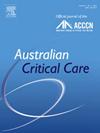Intermittent pneumatic compression can reduce the incidence of upper extremity venous thrombosis after peripherally inserted central catheter placement in traumatic brain injury patients: A randomised controlled trial
IF 2.7
3区 医学
Q2 CRITICAL CARE MEDICINE
引用次数: 0
Abstract
Background
Peripherally inserted central catheters (PICCs) are commonly used in patients with traumatic brain injury (TBI) in neurosurgical intensive care units. A frequent complication of this procedure is upper-extremity venous thrombosis (UEVT), which can lead to adverse outcomes.
Objectives
The objective of this study was to evaluate the effectiveness of intermittent pneumatic compression (IPC) in reducing the incidence of UEVT in patients with TBI undergoing PICC placement.
Methods
Patients with TBI admitted to our neurosurgical intensive care unit between 2021 and 2023 were included in the study. All patients underwent PICC placement and were randomly assigned to a control or intervention group. The intervention group received IPC on the upper limb. Doppler ultrasound was used to detect venous thrombosis and measure blood flow in the upper extremity. Differences in blood flow velocities between the groups at specified time points were analysed using the Mann–Whitney U and Wilcoxon signed-rank tests.
Results
The intervention group showed significantly lower rates of UEVT (4.1% vs. 18.6%, P = 0.001), deep vein thrombosis (1.0% vs. 8.2%, P = 0.018), and superficial vein thrombosis (3.1% vs. 10.3%, P = 0.042) than the control group. Venous flow velocities on days 14 and 28 after catheterisation were significantly higher in the intervention group (all P < 0.001), while no significant differences were observed on days 0 and 7.
Conclusion
IPC can reduce the incidence of UEVT and improve blood flow in the catheterised upper extremity in patients with TBI after PICC placement.
一项随机对照试验:间歇性气动压缩可减少外伤性脑损伤患者外周置管后上肢静脉血栓的发生率
背景:在神经外科重症监护病房中,外伤性脑损伤(TBI)患者通常使用外周插入中心导管(PICCs)。该手术的常见并发症是上肢静脉血栓形成(UEVT),可导致不良后果。目的:本研究的目的是评估间歇气动压缩(IPC)在减少接受PICC放置的TBI患者UEVT发生率方面的有效性。方法研究纳入了2021年至2023年在我院神经外科重症监护病房住院的TBI患者。所有患者均接受PICC植入,并随机分为对照组或干预组。干预组接受上肢IPC。采用多普勒超声检测上肢静脉血栓形成及血流量。使用Mann-Whitney U和Wilcoxon符号秩检验分析两组在特定时间点的血流速度差异。结果干预组UEVT发生率(4.1%比18.6%,P = 0.001)、深静脉血栓发生率(1.0%比8.2%,P = 0.018)、浅静脉血栓发生率(3.1%比10.3%,P = 0.042)均显著低于对照组。干预组患者置管后第14、28天静脉血流速度显著高于对照组(P <;0.001),而在第0天和第7天没有观察到显著差异。结论外伤性脑损伤患者PICC置入术后,ipc可降低UEVT发生率,改善上肢血流量。
本文章由计算机程序翻译,如有差异,请以英文原文为准。
求助全文
约1分钟内获得全文
求助全文
来源期刊

Australian Critical Care
NURSING-NURSING
CiteScore
4.90
自引率
9.10%
发文量
148
审稿时长
>12 weeks
期刊介绍:
Australian Critical Care is the official journal of the Australian College of Critical Care Nurses (ACCCN). It is a bi-monthly peer-reviewed journal, providing clinically relevant research, reviews and articles of interest to the critical care community. Australian Critical Care publishes peer-reviewed scholarly papers that report research findings, research-based reviews, discussion papers and commentaries which are of interest to an international readership of critical care practitioners, educators, administrators and researchers. Interprofessional articles are welcomed.
 求助内容:
求助内容: 应助结果提醒方式:
应助结果提醒方式:


